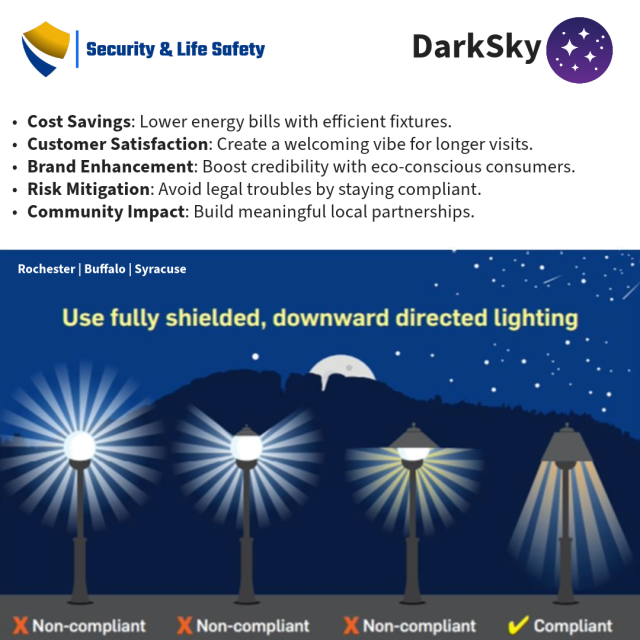An Investment in Sustainability and ProfitabilityThe Business Case for Dark Sky Compliant Lighting:ROCHESTER
Introduction
In an era where businesses are held to higher social and environmental responsibility standards, adopting Dark Sky-compliant lighting is more than a fad or buzzword; it’s imperative. Despite the growing interest in sustainable business practices, the issue of light pollution remains primarily overlooked, posing environmental, economic, and health-related risks. The concept of “Dark Sky” aims to combat this overlooked issue. But what exactly does Dark Sky compliance mean, and why should your business take this seriously? The answers highlight ethical responsibility and make a compelling business case.
What is Dark Sky?
Dark Sky refers to the movement and standards to reduce light pollution. Led by organizations like the International Dark-Sky Association (IDA), the initiative educates businesses and communities about the importance of preserving natural nightscapes. Dark Sky-compliant lighting minimizes glare, reduces light spill, and focuses illumination only where needed—ultimately reducing energy consumption and contributing to the well-being of wildlife and human communities.

The Consequences of Non-Compliance
Environmental Impact
Light pollution has a severe impact on the environment. It disrupts the natural behavior of wildlife, including migration patterns and reproduction cycles. Artificial light negatively affects many animals, leading to dwindling populations and imbalanced ecosystems.
Human Health
Constant exposure to artificial light has been shown to disrupt human circadian rhythms, contributing to sleep disorders, stress, and even more severe health problems like heart disease and depression.
Economic Cost
Non-compliant lighting systems are often inefficient, leading to higher electricity bills. Inefficient lighting wastes energy and money—resources that could be better spent elsewhere in your business operations.
Benefits of Dark Sky-Compliant Lighting for Your Business
Energy Savings
Dark Sky-compliant fixtures are designed to be energy-efficient. These fixtures often incorporate LED technology, which lasts longer and consumes less electricity. Energy savings translate directly to financial savings, creating a win-win situation for the business and the environment.
Enhancing Customer Experience
Businesses that adopt Dark Sky-compliant lighting clearly state their commitment to social and environmental responsibility. This can be a distinguishing factor for consumers who prefer supporting sustainable brands, enhancing customer loyalty and retention.
Regulatory Compliance and Incentives
Many jurisdictions are implementing regulations to combat light pollution. Proactively adopting compliant lighting can save your business from fines and legal complications. Several local and state governments offer financial incentives for implementing energy-efficient lighting systems, including Dark Sky-compliant fixtures.
Improved Safety
Contrary to the misconception that brighter is safer, glare from non-compliant lighting can impair vision and create unsafe conditions. Dark Sky lighting provides even illumination, increasing visibility and safety for both customers and employees.
Employee Well-being
Employees also benefit from an improved lighting environment. Reducing glare and harsh lighting can contribute to a more comfortable workspace, potentially increasing productivity and reducing eye strain and fatigue.
The Bottom Line
Adopting Dark Sky-compliant lighting is not just an ethical decision; it’s a sound business investment. The immediate and long-term benefits significantly outweigh the costs, offering savings and sustainability for years. In a world increasingly conscious of environmental stewardship, transitioning to Dark Sky compliance places your business ahead of the curve, fortifying its reputation and profitability.
Start the journey towards responsible lighting today, and shine a light on your business’s commitment to a brighter—yet darker—future.
Don’t be left in the dark. Join the Dark Sky movement now.
Dark Sky Federal and New York State RegulationsDARK SKY
As of my last update in September 2021, there were no specific federal laws mandating Dark Sky compliance across the United States. The issue has generally been addressed at the state and local levels, with several municipalities adopting regulations and guidelines to control light pollution.
In the case of New York State, various cities and towns have adopted local ordinances to reduce light pollution and encourage Dark Sky compliance. These ordinances often require businesses and residents to use lighting fixtures that minimize light spills and glare, especially in sensitive areas like beaches or natural reserves. However, it should be noted that New York State had not passed comprehensive legislation at the state level for Dark Sky compliance as of 2021.
The most relevant federal regulation that indirectly affects light pollution is the Energy Policy Act, which encourages energy efficiency and could potentially lead to the adoption of Dark Sky-compliant fixtures due to its emphasis on efficiency. Various tax incentives and grants provided at the federal level for energy-efficient technologies could indirectly promote Dark Sky compliance as well.
While not a law, the U.S. National Park Service has a “Natural Sounds and Night Skies Division” that protects the acoustic and night sky environments in America’s national parks, which could influence broader federal policy in the future.
Given the rapidly evolving nature of environmental regulation, it’s advisable to consult current legal resources for the most accurate and up-to-date information. And let’s not forget, staying ahead of the legislative curve is not only smart—it’s a win for the environment, your customers, and, ultimately, your bottom line.


